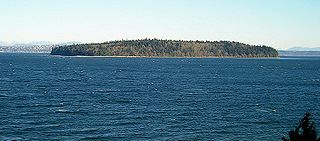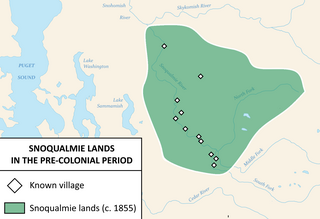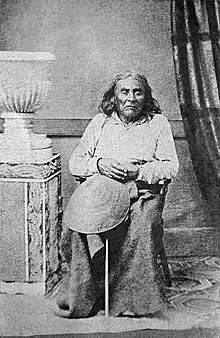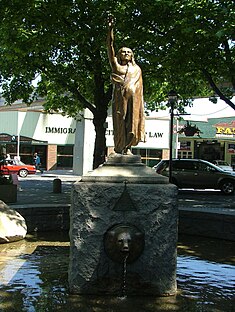
The Muckleshoot are a Lushootseed-speaking Native American tribe, part of the Coast Salish peoples of the Pacific Northwest. They are descendants of the Duwamish peoples whose traditional territory was located along the Green and White rivers, including up to the headwaters in the foothills of the Cascade Mountains, in present-day Washington State. Since the mid-19th century, their reservation is located in the area of Auburn, Washington, about 15 miles (24 km) northeast of Tacoma and 35 miles (55 km) southeast of Seattle.
The Nisqually are a Lushootseed-speaking Native American tribe in western Washington state in the United States. They are a Southern Coast Salish people. They are federally recognized as the Nisqually Indian Tribe, formerly known as the Nisqually Indian Tribe of the Nisqually Reservation and the Confederated Tribes of the Chehalis Reservation.

The Suquamish are a Lushootseed-speaking Native American people, located in present-day Washington in the United States. They are a southern Coast Salish people.

The Duwamish are a Lushootseed-speaking Southern Coast Salish people in western Washington, and the Indigenous people of metropolitan Seattle.
Lushootseed, formerly known as Puget Salish, Puget Sound Salish, or Skagit-Nisqually, is a Central Coast Salish language of the Salishan language family. Lushootseed is the general name for the dialect continuum composed of two main dialects, Northern Lushootseed and Southern Lushootseed, which are further separated into smaller sub-dialects.

Chief Leschi was a chief of the Nisqually Indian Tribe of southern Puget Sound, Washington, primarily in the area of the Nisqually River.

Blake Island is a Puget Sound island in Kitsap County, Washington, United States, that is preserved as Blake Island Marine State Park. The island lies north of Vashon Island, south of Bainbridge Island, and east of Manchester. On the northeast end of the island is Tillicum Village, a tourist attraction based on Northwest Coast Indian arts, culture, and food. The park is managed by the Washington State Parks and Recreation Commission.

The Suquamish Indian Tribe of the Port Madison Reservation is a federally recognized tribe and Indian reservation in the U.S. state of Washington.

The Puget Sound War was an armed conflict that took place in the Puget Sound area of the state of Washington in 1855–56, between the United States military, local militias and members of the Native American tribes of the Nisqually, Muckleshoot, Puyallup, and Klickitat. Another component of the war, however, were raiders from the Haida and Tlingit who came into conflict with the United States Navy during contemporaneous raids on the native peoples of Puget Sound. Although limited in its magnitude, territorial impact and losses in terms of lives, the conflict is often remembered in connection to the 1856 Battle of Seattle and to the execution of a central figure of the war, Nisqually Chief Leschi. The contemporaneous Yakima War may have been responsible for some events of the Puget Sound War, such as the Battle of Seattle, and it is not clear that the people of the time made a strong distinction between the two conflicts.

The Old Man House was the largest winter longhouse in what is now the U.S. state of Washington, once standing on the shore of Puget Sound. It was the center of the Suquamish village of dxʷsəq̓ʷəb on Agate Pass, just south of the present-day town of Suquamish. At one time, it was home to the famous Suquamish chiefs Kitsap and Seattle.
The Sammamish people are a Lushootseed-speaking Southern Coast Salish people. They are indigenous to the Sammamish River Valley in central King County, Washington. The Sammamish speak Lushootseed, a Coast Salish language which was historically spoken across most of Puget Sound, although its usage today is mostly reserved for cultural and ceremonial practices.
In the history of Seattle before white settlement, thirteen prominent villages existed in what is now the city of Seattle. The people living near Elliott Bay, and along the Duwamish, Black and Cedar Rivers were collectively known as the doo-AHBSH, or People of the Doo ("Inside"). Four prominent villages existed near what is now Elliott Bay and the (then-estuarial) lower Duwamish River. Before civil engineers rechanneled the Duwamish, the area had extensive tidelands, and had an abundance of seafoods.
The region now known as Seattle has been inhabited since the end of the last glacial period. Archaeological excavations at West Point in Discovery Park, Magnolia confirm that the Seattle area has been inhabited by humans for at least 4,000 years and probably much longer. West Point was called Oka-dz-elt-cu, Per-co-dus-chule, or Pka-dzEltcu. The village of tohl-AHL-too had been inhabited at least since the 6th century CE, as had hah-AH-poos—"where there are horse clams"—at the then-mouth of the Duwamish River in what is now the Industrial District. The Lushootseed (Skagit-Nisqually)-speaking Salish Dkhw'Duw'Absh and Xacuabš —ancestors of today's Duwamish Tribe—occupied at least 17 villages in the mid-1850s and lived in some 93 permanent longhouses (khwaac'ál'al) along the lower Duwamish River, Elliott Bay, Salmon Bay, Portage Bay, Lake Washington, Lake Sammamish, and the Duwamish River tributaries, the Black and Cedar Rivers.
The Duwamish Tribe, officially known as the Duwamish Tribal Organization, is an unrecognized tribe of Duwamish people, and those who identify as their descendants, based in Seattle, Washington.

The Battle of Seattle was a January 26, 1856 attack by Native American tribesmen upon Seattle, Washington. At the time, Seattle was a settlement in the Washington Territory that had recently named itself after Chief Seattle (Sealth), a leader of the Suquamish and Duwamish peoples of central Puget Sound.

Chief Patkanim was chief of the Snoqualmoo (Snoqualmie) and Snohomish tribe in what is now modern Washington state.

The Snoqualmie people are a Lushootseed-speaking Southern Coast Salish people indigenous to the Snoqualmie Valley, located in east King and Snohomish counties in the state of Washington.
The Steilacoompeople are Lushootseed-speaking Southern Coast Salish people, indigenous to the southern Puget Sound region of Washington state.

The Shilshole people were a Lushootseed-speaking people whose territory was located around Salmon Bay near Seattle, Washington. Around the 19th century, they had just one village deep inside Salmon Bay. The last Shilshole were removed from their homes in 1914, and moved to the Port Madison Reservation to enable the construction of the Ballard Locks, although some assimilated into the nearby community of Ballard.















